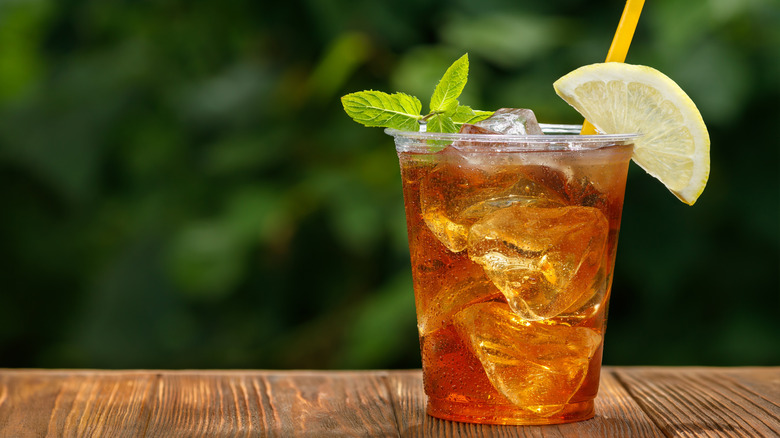How The 1904 World's Fair Helped Make Iced Tea A Summer Favorite
If we told you that the most consumed beverage in the world is water, then what beverage do you think would be second? Coffee? Beer? Maybe some type of soft drink? Those would be good guesses. But, as the title of this article might indicate, the right answer is tea. According to the Tea Association of the U.S.A. Inc., not only is tea the second most popular beverage in the world, but it's also consumed by 160 million Americans every day. In 2024, Americans consumed 4 billion gallons of tea.
In the grand scheme, tea is relatively new as a beverage of choice in the United States. As ice became more prevalent in the U.S. in the 1800s, thanks to northern shipments to the South, many Southerners got an early taste of what would be the drink of choice for future generations. At that time, though, tea was more of a mixer for alcoholic drinks. According to an NPR interview with liquor historian David Wondrich, a Regent Punch was one early alcoholic drink that included green tea, arrack, citrus juice, sugar, champagne, brandy, and rum.
It wasn't until the early 20th century that Americans really started embracing tea as a beverage that could stand on its own. That pivotal moment came at the 1904 World's Fair in the summer heat of St. Louis, Missouri.
Iced tea goes mainstream
When 20 million people get together in the middle of a hot St. Louis summer, they naturally might want to find something refreshing to drink. That's exactly what happened at the 1904 World's Fair, and their refreshing drink of choice turned out to be iced tea — but iced tea's popularity didn't stop there. This World's Fair (which also popularized mustard as the condiment of choice on hot dogs) help iced tea go mainstream when those 20 million visitors returned to their homes in countries across the world.
Nearly two decades later, Prohibition took hold in the United States and ended any legal way of drinking alcoholic punches mixed with tea. According to NPR, that's when iced tea really went mainstream -– as stronger versions of it appeared in clubs and hotel restaurants that needed some type of beverage to replace alcohol. Around the same time, freezers and refrigerators became available as home appliances, which made iced tea even more accessible and convenient. This allowed tea drinkers to make their favorite beverage on the rocks without ever leaving home. From there, iced tea became a thing all over the world, it eventually became the unofficial drink of the South, and its popularity in the U.S. only grew from there.
Whether it's hot, cold, sweet, or unsweetened, Americans love tea. If it hadn't been for that hot St. Louis summer in 1904, though, we might not have ever known the refreshing feeling of drinking a tall glass of iced tea on a hot summer day.

